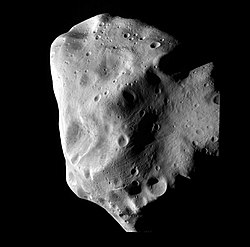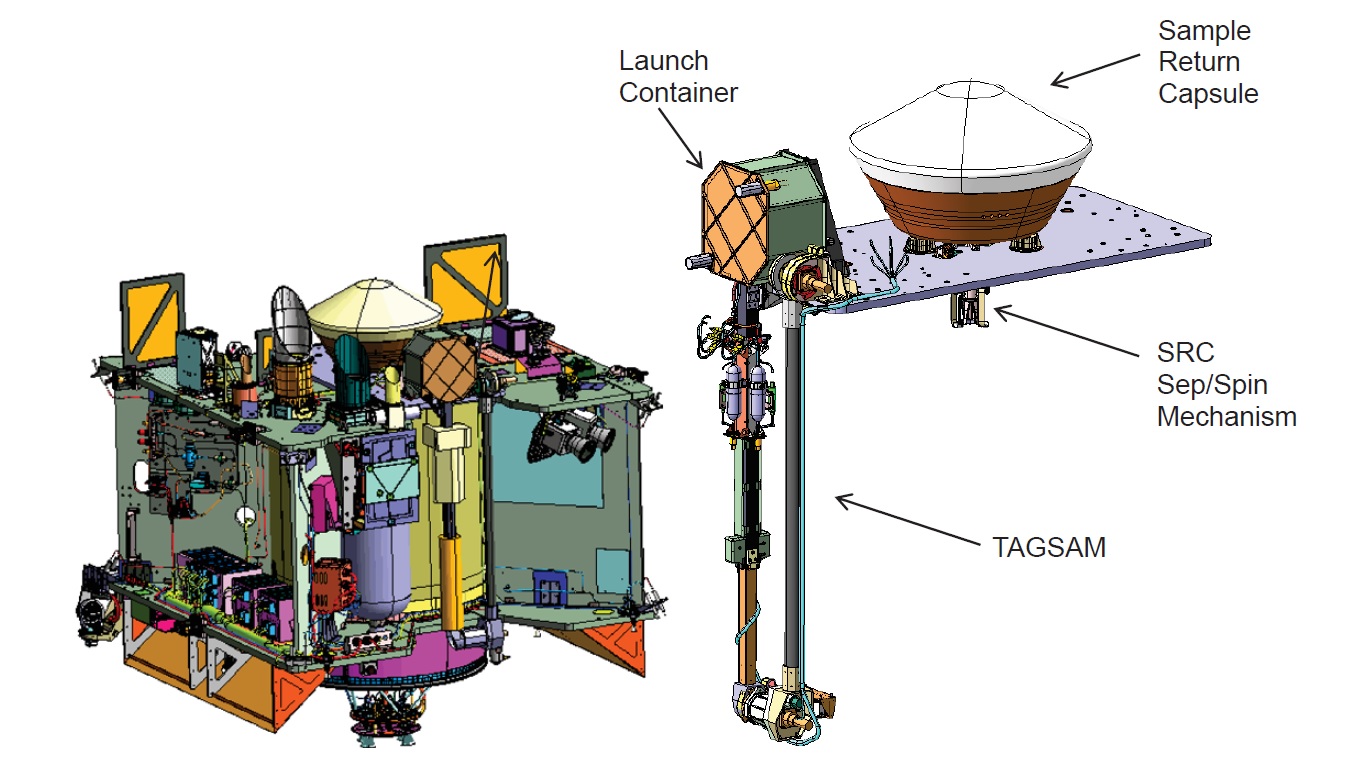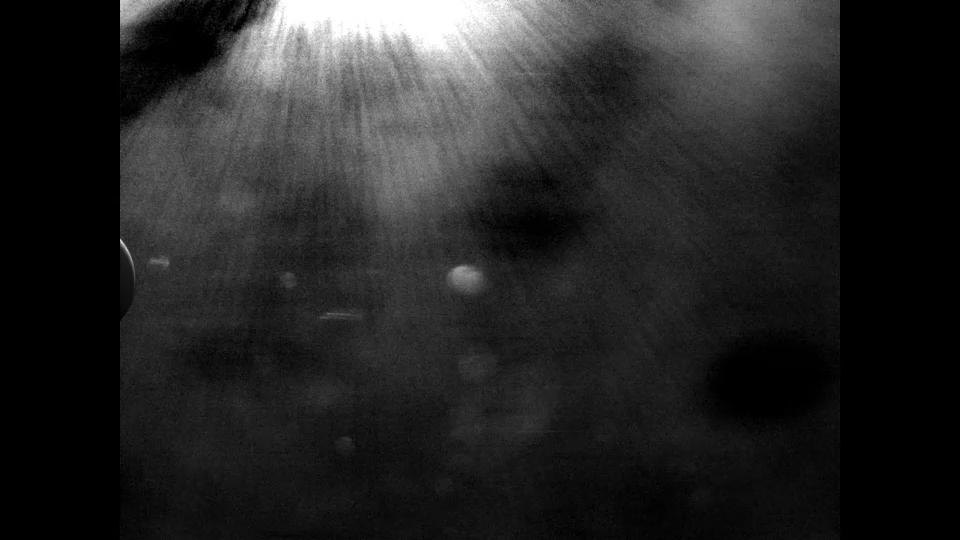-
Posts
264 -
Joined
-
Last visited
Content Type
Profiles
Forums
Developer Articles
KSP2 Release Notes
Bug Reports
Posts posted by IonStorm
-
-
5 hours ago, darthgently said:
Dang, looks plenty metallic to me
Mostly silicates though
-
On 5/11/2024 at 11:54 AM, tater said:
Any current sense of overall composition of Bennu? Was thinking about mining, and the % of useful elements.
The short answer is it is similar to a CI chondrite, which is similar to Solar abundances of refractory elements. It is also very high in H, C, and especially N relative to carbon-rich meteorites.
Below is combined data of Table 4 and Table 3 from the first paper (just accepted) on the results. https://arxiv.org/abs/2404.12536 with the elemental abundances. Missing elements were not measured by these techniques. The majority is silicate, sulfide, carbonate, and magentite though. Detailed results in publications to come. Other information can be found in conference abstracts, e.g.:
- https://www.hou.usra.edu/meetings/lpsc2024/technical_program/?session_no=253
- https://www.hou.usra.edu/meetings/lpsc2024/technical_program/?session_no=403
- https://www.hou.usra.edu/meetings/lpsc2024/technical_program/?session_no=303
This public lecture was recorded and I hope it will be made available: https://agu.confex.com/agu/abscicon24/meetingapp.cgi/Session/223328
Element
wt%
H
0.93
He
Li
0.000149
Be
B
C
4.5
N
0.25
O
F
Ne
Na
0.5826
Mg
10.0303
Al
0.8614
Si
P
0.1052
S
Cl
Ar
K
0.0542
Ca
0.8527
Sc
0.00061
Ti
0.0453
V
0.0053
Cr
0.2671
Mn
0.1965
Fe
18.8831
Co
0.0531
Ni
1.1588
Cu
0.0134
Zn
0.0325
Ga
0.00101
Ge
As
0.000167
Se
0.00249
Br
Kr
Rb
0.000243
Sr
0.000755
Y
0.000149
Zr
0.000371
Nb
0.000031
Mo
Tc
Ru
Rh
Pd
Ag
0.000024
Cd
0.000068
In
0.000008
Sn
Sb
0.000016
Te
0.000257
I
Xe
Cs
0.000021
Ba
0.000248
La
0.000024
Ce
0.000063
Pr
0.000009
Nd
0.000049
Pm
Sm
0.000016
Eu
0.000006
Gd
0.000021
Tb
0.000004
Dy
0.000026
Ho
0.000005
Er
0.000017
Tm
0.000003
Yb
0.000017
Lu
0.000003
Hf
0.000011
Ta
0.000002
W
Re
Os
Ir
Pt
0.00009
Au
Hg
Tl
0.000015
Pb
0.000245
Bi
0.000012
Po
At
Rn
Fr
Ra
Ac
Th
0.000003
Pa
U
0.000001
Total
38.83%
-
I have done a lot of reading. Though my Ph.D. Is in biochemistry, my career and dissertation have been on astrobiology (and exobiology when it was called that). We know from the Stardust mission that there are high temperature grains in comet Wild 2, and presumably other Jupiter family comets. This point to the early solar system being well mixed. There are also minerals that indicate aqueous history (copper iron sulfide) in Wild 2. It could mean cometary micro liquid phases, oceans, or transport from other objects. We need a comet surface sample return mission to find out. The meteorites hypothesized to come from a comet (e.g., CI1 type) but without an unaltered comet to compare against we can’t know. It has been theorized that Ryugu and Bennu are extinct comets. Also note that the distinction between comet and asteroid is fuzzy.
-
11 minutes ago, AckSed said:
Wait a sec... Bennu's samples have a crust of phosphates. Asteroids like Bennu make up a large proportion of all asteroids. And Earth's atmosphere is under bombardment all the time from meteorites and micro-meteorites.
How much phosphorous is deposited on Earth yearly by these? It's probably miniscule, but over a million years? Two? Fifty? How did almost all mammalian and reptilian life on Earth come to have biological scaffolds utilising phosphates?
There are other meteorite types with phosphorous (Table 1 https://www.geo.arizona.edu/xtal/group/pdf/EarthScienceReviews_221_2021_103806.pdf). The fairly pure salt is unusual. Some was seen on Ryugu samples as well, but they are different. There is lots of P in the Earth's crust as well. The problem with phosphate is is usually gets bound in insoluble calcium phosphate. Magnesium phosphate is more accessible. There is still a lot of work to figure out the details of the form of phosphate and any organophosphates.
Phosphate use in biology is far older and more fundamental than animals. Phosphates are a critical subunit of DNA and RNA, lipids, and metabolic intermediates. Here's a classic (and relatively accessible paper if you skip over some of the chemistry) on it https://www.science.org/doi/epdf/10.1126/science.2434996
-
53 minutes ago, AckSed said:
Just look at the stupendous precision of OSIRIS-APEX's interception orbit. Just... look at it:
Side question: how's opening the capsule going?
To be fair, this is the anticipated trajectory. As always there will be course correction maneuvers along the way to precisely adjust and make up for any under or over burns. For the rendezvous with Earth last year there were 4 maneuvers (and numerous backups that were not needed) to slowly nudge the spacecraft to Earth intercept and landing on target. Nevertheless the maneuvers are still remarkable:
- Smallest maneuver 0.1 mm/s; largest 431 m/s
- 10 orbit insertions; 127 deep space maneuvers
- First frozen orbit at a small body
- 37k optical navigation images
- Lowest orbit (832 m semimajor axis) around smallest object (490 m ave.)
- One safe mode in 7 years (human error outbound cruise)
Arrival to departure:
Also, your timing is great. The stuck fasteners were removed yesterday! https://blogs.nasa.gov/osiris-rex/2024/01/11/nasas-osiris-rex-team-clears-hurdle-to-access-remaining-bennu-sample/
-
Check yo staging
-
10 hours ago, cubinator said:
Also suitable for hugging https://youtube.com/clip/Ugkxwvmgu5pYxyFCRWorUCLpQ76j0F9PRSEu?si=nBBC5366t8gBDecC
-
2 hours ago, JoeSchmuckatelli said:
I'm wondering if they don't find a loosely-(gravity)-bound layer of 'regular asteroid' junk adhered to the exterior of the main body. Possibly a lunar like layer of regolith that precludes sampling of the main body...
I. E. Is it likely that the gravity of Psyche gathered up normal space junk during its lifetime such that reaching the presumed metallic core is difficult / impossible?
Or is it more likely that any regolith layer would be more revealing of the interior due to bombardment lifted and gravity settled ejecta overpopulating any regolith layer with exactly what they're looking for?
I know @IonStormis working on a different project... But you are a professional working in this field; are there any predictions about what the Psyche team might find?
I'm out of my expertise of organic astrochemistry here, but the spectral classification (class M) is based on reflectance spectra mostly in the visible. Such a reflectance is based on the topmost material, thus the preponderance of material in the spectrum is responsible for the class M feature: featureless spectrum, flat or red than blue and low-middle albedo. Thus, whatever geology is responsible for the Class M spectra would be on display to the Psyche mission. 21 Lutetia was imaged by Rosetta in 2010 (Figure 1 ) is also a class M asteroid, though with a little lower density than more recent values for 16 Psyche. The more recent Scott Manley video on Psyche discusses some of the astronomy of the object (Figure 2). OSIRIS-REx wishes Psyche an uneventful outbound cruise and a good luck at understanding this strange asteroid (Figure 3).

Figure 1. Class M asteroid 21 Lutetia
Figure 2. Scott Manley discusses some 16 Psyche astronomy starting at 1:30.

Figure 3. Curators take a break in the OSIRIS-REx cleanroom to watch the Psyche launch.
-
1 hour ago, cubinator said:
Would be nice to have one on standby for the next interstellar visitor too.
I'd love an intercept to an interstellar object. This is difficult though there are some ideas. Remember that, these can be at any inclination, including retrograde, and at very high speeds. So you need a whole lot of ∆V. You don't have a lot of time from discovery so there probably isn't time to do a bunch of gravity assists. But I'm just guessing.

Storage costs are also not nothing. The refurbishment of DSCOVR was in the dozens of $M (I don't have a good source on the number and haven't looked too hard) but the 2-year delay of InSight was about $150M ($RY).
-
1 hour ago, StrandedonEarth said:
That’s been my view towards asteroid prospecting: relatively inexpensive, mass produced probes launched at every convenient target
Depending on how you define inexpensive. Both OSIRIS-REx and Psyche cost around $1B each for cost perspective. I don't know that a cubesat is up to the task and the telecom downlink cost is also not nothing, let alone the launch vehicle. The lesson of faster-better-cheaper (pick two) means that if you want faster and cheaper, you and your financial backers need to be good with a high failure rate. Also with 1.3M asteroids it depends on how you define convenient, there could be a lot of launches with a long travel time. But it would be cool.
-
2 hours ago, AckSed said:
Question: If you didn't have to keep mass down (say you had ~15t to LEO), but had the same budget, and used commercial off-the-shelf hardware, what could a successor to OSIRIS-REx be like? Where would you send it? I know hardware costs are only a fraction of the program's costs, but it's a significant one all the same.
OSIRIS-REx had a wet mass of 2.1 tonnes. The costs are really development and testing of the hardware--almost entirely labor. Depending on how you define COTS there is no sample return capsule. So I guess you would spend all that mass on fuel to slow enough to enter orbit to dock with Dragon (if that counts at COTS).
There has been a lot of argument if Ryugu (or perhaps Bennu) is an extinct comet. Since we have never returned unaltered comet material (Stardust dust from Wild 2 was heated upon impact with the aerogel collector), a sample from a comet would be the next step. The CAESAR mission concept (not selected in favor of Dragonfly) would have returned a cold sample from a comet. With more mass I would add active cooling. For OSIRIS-REx, I would have a sealed SRC (that requires a lot of mass to keep it under vacuum) or just launch a fleet of OSIRIS-REx's to different primitive asteroids or different spots on one. Making a bunch of OSIRIS-RExs would lower the unit cost.
-
18 minutes ago, JoeSchmuckatelli said:
That is actually fascinating - how would it be ice, if not from the asteroid?
There are two possible sources of ice.
1. The most probable is Florida. Water adsorbed on the spacecraft before launch can be lost to space (see https://www.asteroidmission.org/?mission_update=dec-11-2017) but it can also re-condense on the spacecraft. You may have heard of spacecraft doing a rotisserie or barbecue roll which heats the spacecraft evenly and also pushes out water from across the spacecraft. OSIRIS-REx, like many spacecraft, has instruments which can never be pointed into the Sun to keep the optics from being damaged. OSIRIS-REx went through several "toe-dips" to bring sunlight onto the SRC without shining it directly down the instrument apertures to heat up the SRC and drive water out of the porous heat shield and backshell. But some areas, including the bottom of the SRC is always in shadow. Furthermore, to avoid heating the sample only one brief toe-dip was allowed after sample collection. So water from warmer areas of the spacecraft could migrate to this permanently shadowed region.
2. It is also possible that ammonia produced by the hydrazine monopropellant thrusters could freeze out (-78°C) in deeply shaded regions of the spacecraft.
-
1 hour ago, cubinator said:
How was the capsule spun up? Part of the release mechanism, I'd guess?
Exactly. The SRC is attached with a sep/spin mechanism. When the SRC is released the mechanism a spring and screw give the SRC a little push and twist. The spin is for our old friend spin stabilization since the SRC has no guidance or propulsion.

-
Here is the SRC leaving the spacecraft captured by NavCam. The lighting isn't great due to the orientation of the spacecraft needed to aim at Earth. To orient you, glare from the Sun is at the top. The crescent Earth is at the left. The SRC moves from right towards center, you can see it rotating with the connections on the bottom catching the light. In the way are dark blobs buzzing around. These are probably asteroid dust, though ice is also possible.

-
On 9/27/2023 at 2:54 AM, FleshJeb said:
If the asteroid made a faux pas, I hope it's at least a little chon-drite.

(Under no circumstances should I be allowed to make puns.)
During the launch campaign there was a team member who has a notorious love of puns. To tease him I submitted the below fake requirement.
QuoteContaminating language is also a potential risk to the science. The greatest contaminating potential derives from the use of low humor. As such, puns are forbidden around the flight system, launch vehicle, and the OSIRIS-REx team. If puns are required, then a waiver for authorization must be submitted and approved four (4) weeks prior to implementation. The waiver must be approved with concurrence of the Project Manager and the Principal Investigator.
He joked back at a pre-launch review indicating the this requirement had not been met, but without catastrophic consequence.

-
Looks like there's some asteroid outside the sampler.
https://www.youtube.com/live/92g5eiqb_fo?si=iSZqOHw8E_MpQ_cu&t=382

-
3 minutes ago, JoeSchmuckatelli said:
Why the use of respirators by the ground / recovery crew?
Seems like a legacy concern from the 50s.
Does masking up actually protect them from anything in a practical sense?
(I understand the clean room protections - just not the behavior while outside in the desert)
The capsule has two lithium-sulfur dioxide batteries. There is a small chance that they can conflagrate and release toxic gas. So the technicians approach with respirators until their gas sensors show it’s safe. So nothing to do with space or the samples.
-
5 hours ago, tater said:
Who gets to be in the room when they open the sample, @IonStorm?
Today is preparation for shipping. It is Lockheed technicians (who actually put it together 8 years ago) and JSC curators. At JSC they will open the sample canister and do the formal handoff of the hardware to NASA. The PI will also be watching. Then the slow deliberate disassembly to catalogue and distribute the samples.
2 hours ago, HebaruSan said:I'm not sure what impresses me more, NASA's thoroughness in how carefully 15+ people are going through this procedure, or NASA's transparency in letting me watch the whole thing
Thank you. That means a lot. It is very important to share the experience and the science with the world.
And we did rehearse a lot, but so far absolutely flawless. -
Still busy in Utah, but here are some photos.
https://www.flickr.com/photos/nasahqphoto/sets/72177720311435828/ -
12 hours ago, AloE said:
Thank you for sharing those great gif & png!
Thank you! Here are more images from the collection and more.
https://www.asteroidmission.org/galleries/sample-collection-videos-and-images/ -
52 minutes ago, Gargamel said:
IIRC there was some issue getting the sample container to close correctly? Is there any lingering issues with this?
There are two different things. The sample collection device (TAGSAM) was overflowing with sample. So material was leaking into space since the mylar flap was wedged open with rocks. We stowed it quickly to prevent losing more. Still, we collected 250±101g from our 60g requirement.
https://www.asteroidmission.org/wp-content/uploads/2020/10/5_deg_fast_cropped-3-frame-slowed86.gif
We stowed the sample head and checked that it was locked in place.
https://www.asteroidmission.org/wp-content/uploads/2020/10/src_stow_head.png
Then closed the sample return capsule (SRC) lid.
https://www.asteroidmission.org/wp-content/uploads/2020/10/StowCam_SRC-Close-Gif.gif
No lingering issue.
-
The most recent photo of the OSIRIS-REx spacecraft https://www.esa.int/ESA_Multimedia/Images/2023/09/First_view_of_OSIRIS-REx_returning_with_asteroid_sample
-
The burn on 8/17/23 was a ∆V of 3 mm/s. (Not even the smallest burn in OSIRIS-REx history. There was a burn to adjust the phasing of the orbit around Bennu of 0.1 mm/s
It is described in the latest blog https://blogs.nasa.gov/osiris-rex/2023/09/19/osiris-rex-makes-final-course-adjustment-before-sept-24-sample-delivery/ (I wrote the one on May 23 about science https://blogs.nasa.gov/osiris-rex/2023/05/23/guest-blog-bennu-and-some-of-the-biggest-science-questions-of-our-generation/).
You can register to follow along at https://www.nasa.gov/specials/virtualguest/ 84 hours to go!
-
I just saw this amazing KSP recreation of the mission to date.




NASA's OSIRIS-REx
in Science & Spaceflight
Posted
Sorry, I responded without sufficient explanation. The table is based on what a specific instrument is sensitive to. Note the units are parts per million. If you add up everything in the two tables you get a total of 38.8% by mass (18 wt% iron, 10 wt% magnesium, 4.5 wt% carbon, 1 wt% nickel, 1 wt% hydrogen). The rest are the unlisted elements. I'll go back and make it easier to read.
If you read the paper you will see "The PXRD results (Figure 12) show that phyllosilicates are the dominant mineral phase, constituting approximately 80% of the volume. Sulfides account for about 10% of the volume, while magnetite, carbonate, and olivine contribute around 5%, 3%, and 2%, respectively." This is % by volume, not mass so you need to work in the density and elemental abundance to put them on the same scale, which I appreciate is irritating.
It is definitely an undifferentiated object, unlike Psyche.